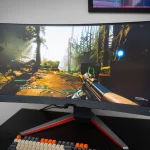How to Reduce CPU Usage While Streaming or Gaming?
You surely would have wondered how to Reduce CPU Usage While Streaming. Well in this article we will answer all your questions.
Because it is the brain of the computer, the CPU is an essential component. However, the CPU may occasionally execute sluggish operations when transmitting or playing a game.
To discover a solution and make connections in this circumstance, you should know how to decrease CPU consumption.
For games and communications, the CPU sends instructions to the graphic card and memory. You’ll need a powerful CPU for all of this since both memory and a graphic card will need to function at their best.
However, if you have too many programs or games active, the CPU will slow down, causing streams to open significantly slower and take longer.
That’s usually because your CPU is overburdened with tasks and can’t cope. Here’s what you’ll need to do to get your computer back up and running.
Does CPU affect streaming?
Many individuals wonder whether the CPU or the GPU should be more important for transmission. And the answer is yes to both of these questions.
However, the functioning and speed of the CPU are more necessary for the transmissions to be realized.
As a result, the first aspect to note while carrying out your transmissions is that you need a powerful CPU. If you stream and play games with the same settings, this becomes much more crucial.
Even the larger gaming broadcasts do it with two CPUs, which is an illustration of this. This demonstrates how critical it is to have a totally solid unit of this kind. To broadcast your games, you must first ensure that your CPU is up to the task.
And although GPU is responsible for picture quality, it is the CPU’s responsibility to transmit such images to communications. As a result, even though both things are important, the CPU is far more so.
Therefore, if you need a computer for these tasks, you should look for a CPU that has the appropriate specifications. You will be able to make all of the transfers you desire while avoiding any hassle.
How Do I Reduce CPU Usage When Streaming?
If you wish to decrease CPU use when streaming, the first step is to turn off any apps that are operating in the background. This should be done while transmitting to minimize the burden on the CPU.
Step 1: To do so, right-click on the taskbar and select “Open Task Manager.”
Step 2: Once you’ve done that, go to processes and right-click on the applications you’d like to execute. You must ensure that they only shut off the run; else, the operating system may be harmed.
Step 3: You may also prevent apps from operating in the background while you broadcast by disabling them at launch. You give the CPU permission to send instructions to the processor so that it can only carry out the transfer you desire.
Because it is typical for the CPU to be overwhelmed with running applications in the background, following easy measures will help your CPU run broadcasts a lot quicker.
As a result, broadcasts or games might become stuck or take a very long time to load and operate.
Thus, if you still don’t have a good and robust CPU, this is the most efficient and straightforward method.
How Do I Make OBS Use Less CPU?
These are the measures to follow to decrease CPU consumption from obs, which is the method most people utilize.
1st step:
Your stream will absorb and travel according to your preferences. Enter the output area once you’ve arrived to make the required changes:
To get started, choose the output mode to advance.
After that, you must set up NVENC’s preset encoder. If you have a powerful Nvidia GPU, you may use it to relieve some of the burdens on your CPU.
The transmission resolution will therefore have to be lowered to 720p to reduce CPU burden.
Additionally, try changing the frequency control to CBR (constant bit rate) mode.
Set the keyframe interval to 2 seconds in the end.
2nd step:
Setting the scale-down filter to bicubic or bilinear is the next step. As a result, the CPU will have less burden and will be able to function more efficiently.
3rd step:
The final stage is to proceed to the advanced portion. You must set the process’ priority to high or above usual in this section.
How Do I Optimize my Computer for Streaming?
You must examine the possibility that your hard disk is clogged with data you don’t want, causing CPU delays. As a result, you must properly remove them in order to reduce the unit’s burden.
You may either manually remove them or utilize cleaning applications to do it for you. These applications are excellent since they maintain your computer clean constantly.
To remove the files manually, you must input percent temp percent. You must hit the enter key to open a folder full of files to search for taskbars, and you must delete all of them.
You may either remove your temporary files yourself or use software like CCleaner to clean your computer. These programs are typically the best solution since they maintain your hard disk clean automatically.
To remove your temp files manually, type percent temp% in the taskbar search box and press enter. You’ll be taken to a new folder where you must remove everything before emptying the garbage.
As a result, your CPU will run more efficiently and with less load, allowing for smoother transmission. So, it’s always a good idea to have automated cleaning, which will keep your hard drive healthy.
Which CPU is best for Streaming?
There are currently numerous CPUs available to carry out transmissions of various quality and costs. You’ll make your decision depending on your requirements, the amount of transmission you want to achieve, the sort of game you want to broadcast, the grade you desire, and the graphics card you’ll use.
All of these are things to think about if you want to choose a CPU that will be beneficial to you. Because transmissions need a high-resolution graphics card and a powerful processor, you’ll need both.
Whenever it comes to casual streaming, it may be set at 720p/30fps with a low bitrate. You should be able to utilize nearly any current CPU with at least four cores and eight threads to make things right.
For professional streamers, though, 720p/30 fps at 2,500 kbps is insufficient. A competent CPU with multiple cores will be of great assistance if you do not require a CPU to handle your high-bit rate 1080p broadcasts.
The following are some of the finest CPUs:
- Amdryzen 3 3300x is the entry-level CPU for streaming.
- Amdryzen 3 3300x is a low-cost streaming CPU.
- Amdryzen 7 3700x is the CPU for mid-range transmissions.
- Intel Core i9-10900k is the best CPU for streaming.
- Amdryzen 9 3950x is a conventional CPU for streaming.
- Amdryzen 3960x thread ripper is the CPU for broadcasting and workstations.
What is a Good CPU Percentage?
When the CPU is inactive, it typically consumes 2-4 percent of its total power. When playing moderate games, the percentage is between 10% and 30%, and up to 70% when playing more intensive games. When your work is crisp and portrayed, you will find it 100 percent.
For instance, when it is discovered on YouTube, the proportion might range between 5% and 15% at most. However, the efficiency of the CPU, as well as the browser and video quality, will play a role.
You should be aware that the proportion of CPU utilization can be influenced by a variety of variables. The graphics card is one of these, and it has the biggest impact, especially if it is utilized for in-game communications. If you have a discrete graphics card that is not incorporated into the CPU, the CPU will do some of the jobs. However, this mode will put less strain on it, allowing it to cool away and prevent overheating.
It’s essential to keep in mind, though, that the CPU idle % is the same across virtually all operating systems. Even though the figures differ, everyone believes that it is always less than 10%, regardless of the CPU and system. As a result, this is the average and the best way to tell if your device is in excellent working order.
Conclusion:
The demand for CPUs has risen in lockstep with the popularity of online gaming streaming. Do not even fret if you’re just getting started with streaming or if you’re on a shoestring. There are several ways to get started without spending hundreds of dollars.
When it comes to high-quality transmission, there are several factors to take into account. When you put greater demands on your transmissions, the chances of failure skyrocket. This is where choosing the right transmitter may assist alleviate the problem and guarantee that your job runs smoothly without any additional losses or delays caused by gear malfunction.
If you have reached here then we hope that you now clearly understand how to Reduce CPU Usage While Streaming. Do try these methods out and let us know how you like them!


